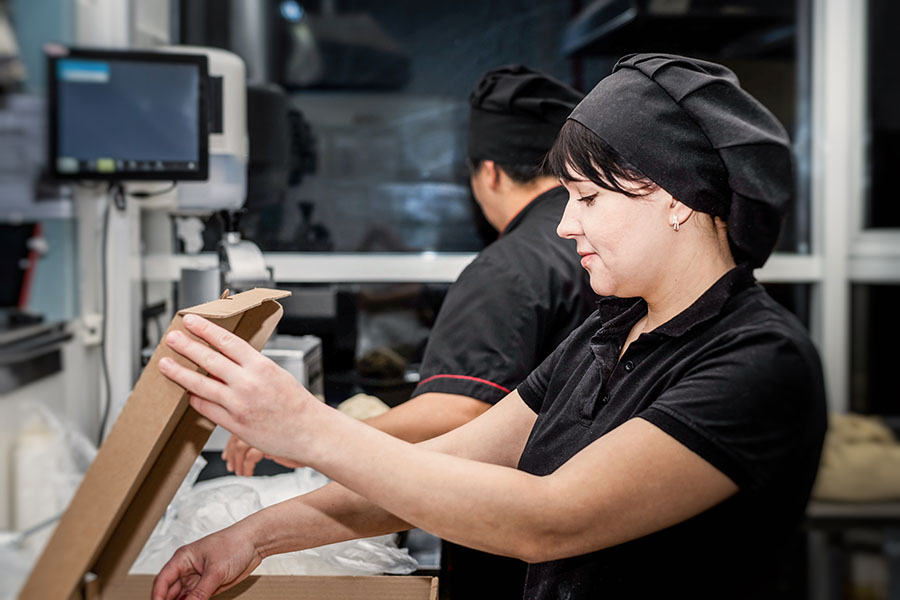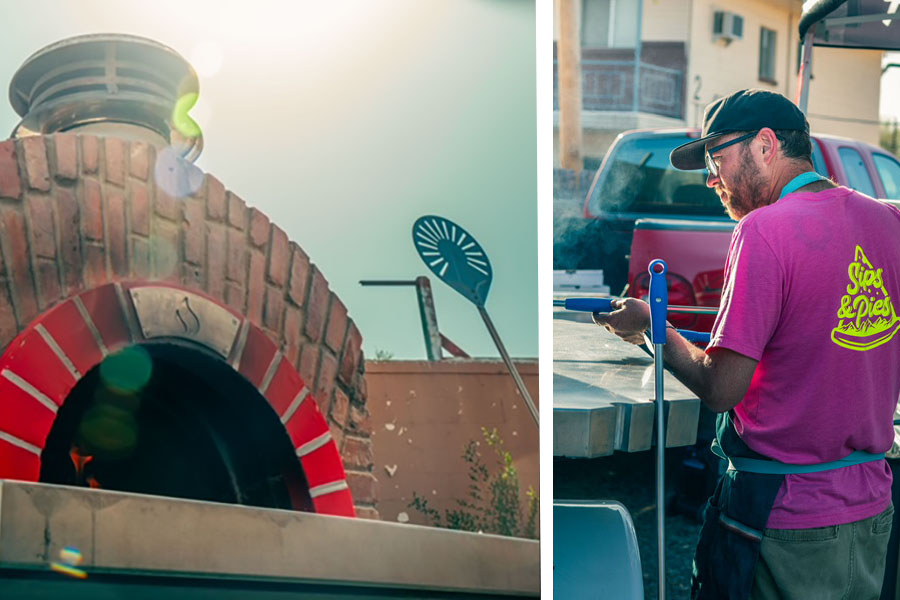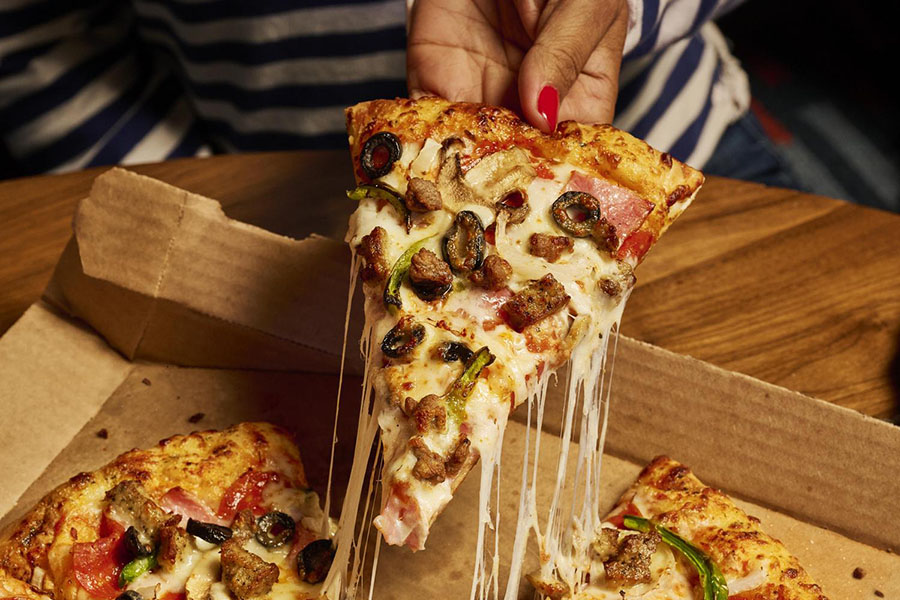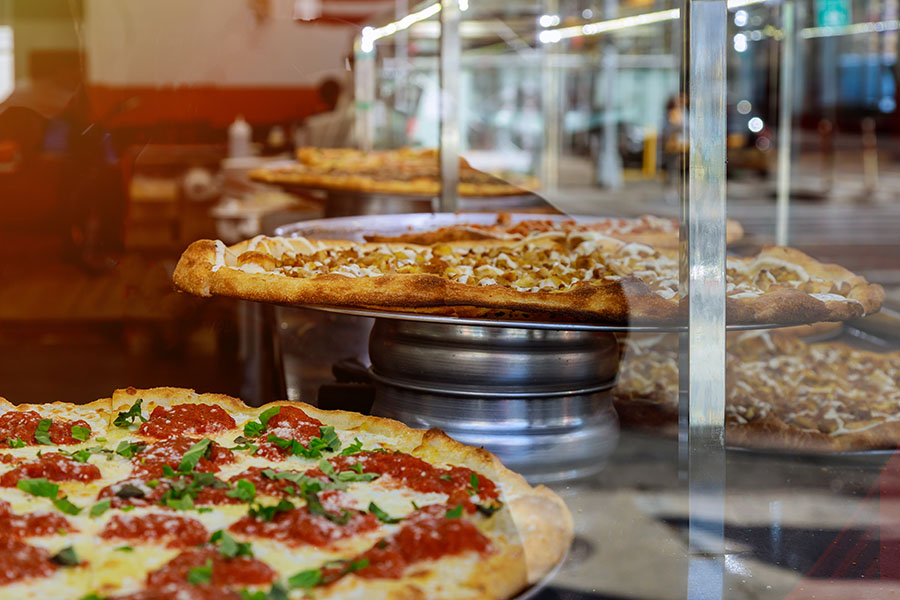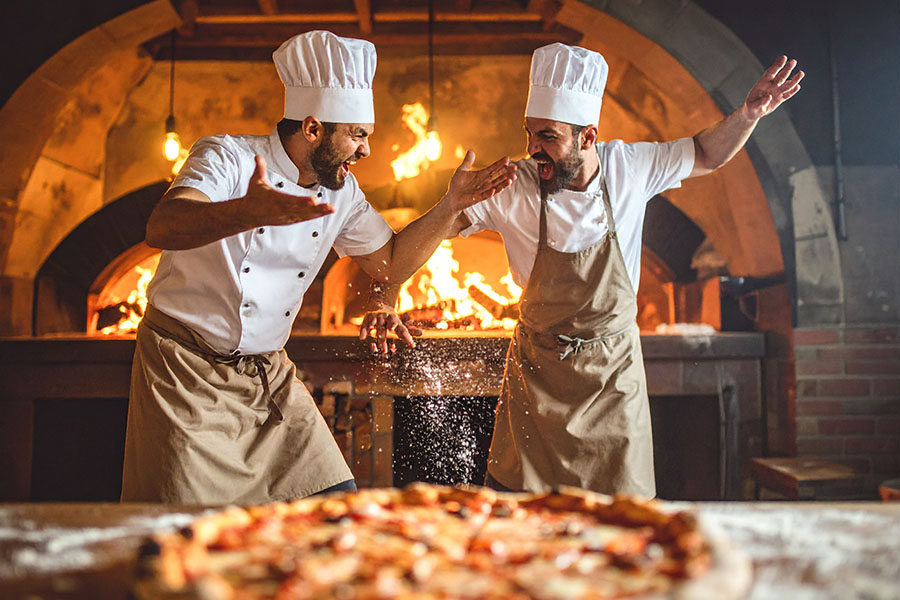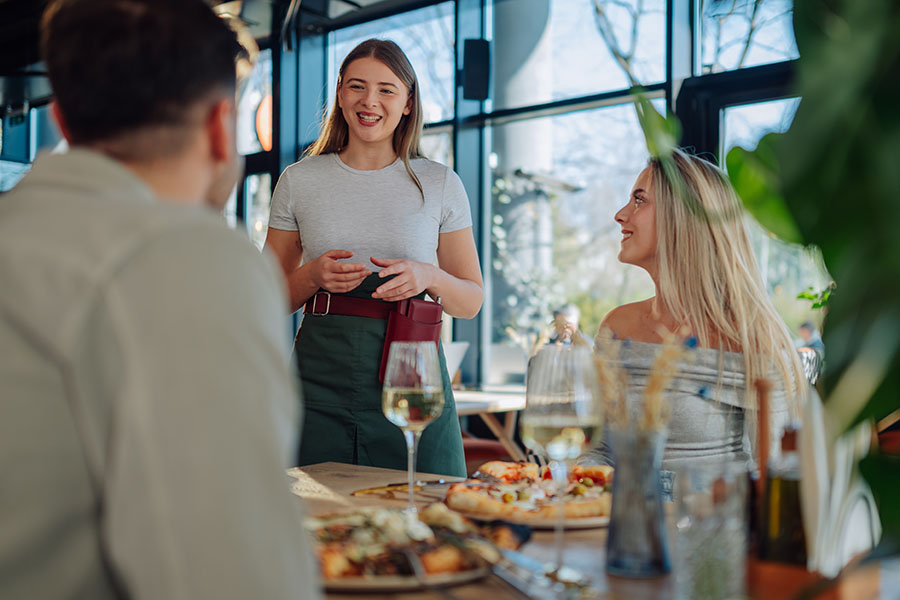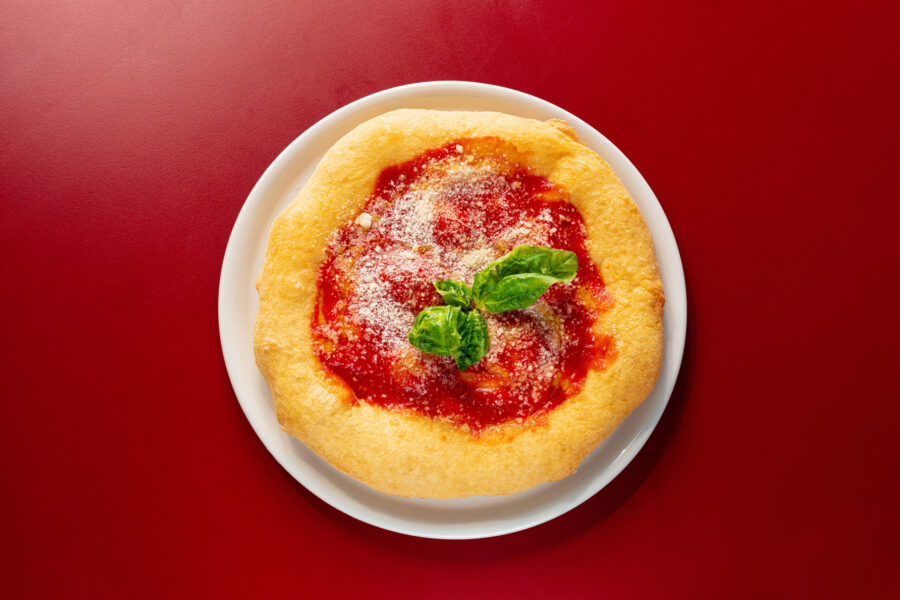 Drive up the Virginia beach coast, and just about every block is peppered with at least one pizzeria, full-service restaurant, bar and shake shack. That’s a lot of white noise to wade through, but Pi-zzeria, with sales at $1.2 million annually, seems to have found its voice. The full-service pizzeria launched in 2003 is part of the gold Key/ Phr hotels & resorts development group, which houses eight different restaurants under its umbrella.
Drive up the Virginia beach coast, and just about every block is peppered with at least one pizzeria, full-service restaurant, bar and shake shack. That’s a lot of white noise to wade through, but Pi-zzeria, with sales at $1.2 million annually, seems to have found its voice. The full-service pizzeria launched in 2003 is part of the gold Key/ Phr hotels & resorts development group, which houses eight different restaurants under its umbrella.
“We didn’t want to do your ordinary pizza,” says Chuck sass, vice president of food and beverage. ”We wanted to do something different … That would be suitable for the visitor market being that we are a resort visitor town, but that would also differentiate ourselves to attract the locals. A lot of the pizza restaurants close at the end of the season.
We wanted to (operate) year-round. “For our portfolio, we found that (pizza) was one of the things that was missing, and at the end of the day, one of the big drivers was the profitability in terms of food costs. Being able to support oceanfront rent requires a year-long business. You have to be profitable to be down in this area.”
 Standing out is key for any restaurant’s success, but for Pi-zzeria, it is crucial. “On the oceanfront, there are 15 different pizzerias, and that’s just from 1st street all the way down to 35th,” says Scott Farrar, director of seasonal outlets for parent company Phr. “Most of them are your walk-in, fast-casual (to-go) places. One of the things about us is that we are truly a sit-down, dine-in restaurant. We’re very kid friendly but we’re adult friendly as well –– everything from the design and layout to the way we handle our guests when they come in the door.
Standing out is key for any restaurant’s success, but for Pi-zzeria, it is crucial. “On the oceanfront, there are 15 different pizzerias, and that’s just from 1st street all the way down to 35th,” says Scott Farrar, director of seasonal outlets for parent company Phr. “Most of them are your walk-in, fast-casual (to-go) places. One of the things about us is that we are truly a sit-down, dine-in restaurant. We’re very kid friendly but we’re adult friendly as well –– everything from the design and layout to the way we handle our guests when they come in the door.
“We give all of the kids who come in dough balls to play with, we have Pi-zzeria tattoos –– we’re just a little bit different from your standard restaurant. They don’t just walk in and we give them a piece of paper and some crayons.”
The restaurant employs about 50 people, “and all cooks have been cross-trained and can cook all stations,” Farrar says. while they have dedicated pizzaiolos, most employees can work the pizza station if needed.
 Although the restaurant is backed by the buying power of its corporate brand, it still operates on an independent basis. Dough and sauces are made in-house, and the company puts its chefs center stage. “We have an exhibition kitchen right here facing Atlantic Avenue so that the people who walk by can see it,” says Farrar. “We have the only rotating brick stone oven at the beach, which gives us another (point) of differentiation between (us) and our competitors.” Nearly 80 percent of sales are pizza based, but “we have a good variety of pasta dishes, different sandwiches, multiple salad offerings –– we have pretty extensive menu offerings for a pizzeria.”
Although the restaurant is backed by the buying power of its corporate brand, it still operates on an independent basis. Dough and sauces are made in-house, and the company puts its chefs center stage. “We have an exhibition kitchen right here facing Atlantic Avenue so that the people who walk by can see it,” says Farrar. “We have the only rotating brick stone oven at the beach, which gives us another (point) of differentiation between (us) and our competitors.” Nearly 80 percent of sales are pizza based, but “we have a good variety of pasta dishes, different sandwiches, multiple salad offerings –– we have pretty extensive menu offerings for a pizzeria.”
To help keep food costs down, the company installed an automated inventory and cost control system that helped shave 4½ percent off their food costs. “we know, for example, if we buy 100 pounds of pepperoni during a given week and we sell a certain amount of the pizzas that we’re supposed to, we can nail it down to the specific cook who might be putting on too many,” Sass says.
 Farrar estimates that nearly half of pizzas sold are traditional one-toppings — but Pi-zzeria have more than 22 specialty pizzerias on their menu. “The selection that you’ll find as far as specialty pizzas is far greater than anything you’ll find down here on the oceanfront,” Farrar says.
Farrar estimates that nearly half of pizzas sold are traditional one-toppings — but Pi-zzeria have more than 22 specialty pizzerias on their menu. “The selection that you’ll find as far as specialty pizzas is far greater than anything you’ll find down here on the oceanfront,” Farrar says.
The top-selling specialty pizza is the Chicken bacon ranch (pepper fried chicken, bacon, ranch dressing and mozzarella) and the gorgonzola (artichokes, spinach, roma tomatoes, pine nuts, red onions, chicken and gorgonzola cheese). The latter “is something that we’re known for,” Farrar adds. “it’s something that you won’t find anywhere else around here.”The East Coast Hawaiian style (slow-roasted barbeque pork, grilled pineapple, mozzarella and apple-smoked bacon) has also been a longtime menu staple.
Adding a small 6-inch pizza has helped increase specialty pizza sales because “where typically you and i might split one type of pizza, now we can have our own individual pizzas,” Sass says. The restaurant does not deliver aside from two hotel properties, but sass says local delivery is in Pi-zzeria’s business plan for 2013. “The reason that we don’t do delivery now is that at 7:30 at night, there’s a line out the door,” he says. “we’re at capacity in terms of our oven space.”
 Aside from the food, alcohol makes up nearly 25 percent of sales. “In terms of alcohol-to-food ratios out of all of our restaurants, it is the lowest, which you would expect in a family friendly atmosphere,” Sass says. Sangria is the restaurant’s signature drink and is made in-house, with three varieties (white, red and a blush) offered by the glass and carafe daily. It’s so popular that it can comprise nearly 50 percent of alcohol sales. “You see a tray coming out with four glasses and a carafe, and the next thing you know the whole restaurant wants to order it,” Farrar says.
Aside from the food, alcohol makes up nearly 25 percent of sales. “In terms of alcohol-to-food ratios out of all of our restaurants, it is the lowest, which you would expect in a family friendly atmosphere,” Sass says. Sangria is the restaurant’s signature drink and is made in-house, with three varieties (white, red and a blush) offered by the glass and carafe daily. It’s so popular that it can comprise nearly 50 percent of alcohol sales. “You see a tray coming out with four glasses and a carafe, and the next thing you know the whole restaurant wants to order it,” Farrar says.
Still, beer and traditional wines are more popular than hard liquor. “We have a decent selection of bottled beers as well as three different beers on tap,” Farrar adds. “We sell frozen drinks as well being that we’re on the beach. Single liquor drinks is probably the least in terms of sales that we do.”
Pi-zzeria handles marketing strategetically — it accounts for nearly three percent of the restaurant’s budget — and its primary target are the nearly 500 hotel rooms under the parent company’s hospitality wing. “We own the rooms, and it’s really the lowest hanging fruit that we have,” Sass says. “we also have five other resorts in which we market in the rooms.”
They also advertise in the abundance of visitors’ guides that line the hotel lobbies and local sidewalks, which is their most effective marketing tool. “You almost have to be in the guidebooks,” Sass says. “with the economy, the visitors are looking for a bargain.” (Pizzeria’s buy one, get one half-off a large pizza is the most effective campaign.)
 While the majority of advertising is geared toward visitors in the summer, the focus in the off-season is on attracting locals. That includes utilizing social media and building sponsorships with local sports teams. “We measure the effectiveness of our marketing programs by each specific campaign, and we review and critique that for the following years,” Sass adds.
While the majority of advertising is geared toward visitors in the summer, the focus in the off-season is on attracting locals. That includes utilizing social media and building sponsorships with local sports teams. “We measure the effectiveness of our marketing programs by each specific campaign, and we review and critique that for the following years,” Sass adds.
The company is looking at expansion for the Pi-zzeria brand, and “if we’re going to do it, we’re going to do it all out,” Sass says. They are actively looking at growth on the oceanfront but also via catering, which will require more labor and oven-capacity.
They would like to open a store at the south end of the beach and another in the central part, which will give them full coverage for delivery.
 The key, says Farrar, will be consistency. “This restaurant, you can come in and i don’t care if it’s December or July, if there (are) two people in here or 200, you’re going to order something and it’s going to come out the same way every time. We have people who come down here every year besides our local clientele that have been coming here since 2003 specifically because of our consistency.”
The key, says Farrar, will be consistency. “This restaurant, you can come in and i don’t care if it’s December or July, if there (are) two people in here or 200, you’re going to order something and it’s going to come out the same way every time. We have people who come down here every year besides our local clientele that have been coming here since 2003 specifically because of our consistency.”
That relentless quality control is what helps Pi-zzeria succeed on a daily basis. says Sass: “With the increasing quality of the chain brands –– and they’re getting better and better, and cheaper and cheaper –– you’ve got to deliver an overall experience versus just good pizza … it’s delivering the whole package.”
Mandy Detwiler is managing editor of Pizza Today.
